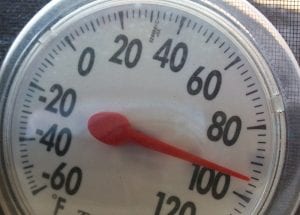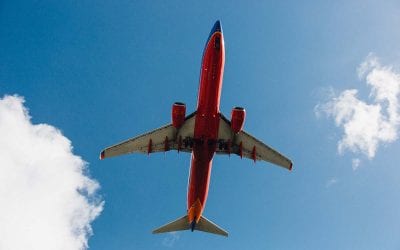The U.S. is in a heatwave across the nation. Summer travelers need to plan, pack and be careful when outdoors during heat waves wherever they’re vacationing.
 As I write this article, where I live in the northeastern U.S., it’s 98°F (36.7°C). The humidity is 43 percent. The weather bureau says it really feels like it’s 104°F (40°C). By any measure I think it’s safe to say it’s sweltering! I walked a couple of blocks to buy something at the local pharmacy. I returned with a drenched shirt. High temperatures near 90°F (32.2°C) up to 98°F (36.7°C) are expected for at least the next ten days here. We’re in a heatwave.
As I write this article, where I live in the northeastern U.S., it’s 98°F (36.7°C). The humidity is 43 percent. The weather bureau says it really feels like it’s 104°F (40°C). By any measure I think it’s safe to say it’s sweltering! I walked a couple of blocks to buy something at the local pharmacy. I returned with a drenched shirt. High temperatures near 90°F (32.2°C) up to 98°F (36.7°C) are expected for at least the next ten days here. We’re in a heatwave.
Fortunately, where I live, the air conditioning is working well. There are many tourists visiting here this summer. Some are clearly taking precautions to deal with the heat, others not so much. I passed one man in shorts and a tight fitting top, sweating profusely and panting, bald with no hat, beet red in the face. If he stayed out much longer, he likely ran into trouble. His wife was trying to convince him to get back to the hotel. I hope she was successful.
Even though heat related illnesses are preventable, in the U.S., about 1,220 people are killed by extreme heat annually.
Heatwave exhaustion can escalate into heat stroke, which is a medical emergency. According to the CDC (Centers for Disease Control and Prevention), they must be treated by a medical professional.
According to the CDC, although heatwave-related deaths and illnesses are preventable, “Approximately 1,220 people in the United States are killed by extreme heat every year.”
The CDC has specific recommendations to help anyone you suspect has heatstroke.
The CDC recommends that if you suspect heatstroke:
- In the U.S., call 911 (generally 112 in Europe) for emergency medical care.
- Stay with the person until emergency medical services arrive.
- Move the person to a shaded, cool area and remove outer clothing.
- Cool the person as quickly as possible.
According to the Mayo Clinic, heat exhaustion symptoms include: cool, moist skin with goose bumps when in the heat, heavy sweating, faintness, dizziness, fatigue, muscle cramps, nausea, headache, etc. Heatstroke symptoms include: fever of 104°F (40°C), confusion, agitation, slurred speech, hot, dry skin or heavy sweating, nausea and vomiting, headache, fainting, etc.
The most important thing to do for anyone you think may have heatstroke is to get emergency medical assistance for them.
With either condition, get the person to a cool place, but if there is a chance it’s heatstroke, call for medical help immediately. For heat exhaustion, stop all activity, sip water and take a bath. If heat exhaustion gets worse, such as if vomiting occurs or a headache worsens, or if the symptoms last longer than an hour, get medical help immediately.
I’ve got planning, packing and traveling tips for you when traveling in potentially excessive heat.
Planning:
Recognize that older adults, infants and young children, as well as those with a chronic medical condition, are more at risk of heat-related illnesses than healthy adults. If you fall into one of those groups yourself or are traveling with someone in those groups, plan your trip to prevent heat-related problems.
Having air conditioners in the home, villa or hotel at which you’re staying is critical. Be certain you’ll have air conditioning wherever you’re staying.
Ensure that any home or villa you’re renting or your hotel has true air conditioning, not just ducts blowing air or ceiling fans. In the U.S., air conditioning is typically less of a problem than in Europe, but don’t assume any place you’re planning to reserve is air conditioned. If you’re not absolutely certain, ask. If you’re renting a property, such as an AirBnB, get the property you’re renting to confirm in writing that it has air conditioning. Don’t forget to ask if you’ll have a thermostat to control the temperature setting yourself wherever you’re staying.
If you’re renting a car during a heatwave, ensure that it’s not only air conditioned, but that it works well.

Packing:
According to the CDC, “The sun’s ultraviolet (UV) rays can damage your skin in as little as 15 minutes. Always pack sunscreen with at least SPF 15 before you go outside. If you’re with tweens, they need a suncreen of SPF 30 or higher. Frankly, higher is better for all. Sunscreen is recommended for everyone six months and older. Infants and babies should be kept out of the sun. Even if you use sunscreen, pack and wear a wide brimmed, UV rated hat. Baseball hats are not nearly as good because they don’t protect your ears or the back of your head. Pack and wear UV protective sunglasses, too.
Definitely pack comfortable clothing and an insulated water bottle. Staying hydrated is essential during a heat wave.
Pack comfortable clothing that wicks perspiration from your body. Pack light colored clothing for daytime wear. Only pack dark colored clothing for evening wear, as dark colors absorb sunlight, heating your body.
Consider packing a handheld fan. Pack a travel umbrella in case of rain and you can use it for shade in case you need to walk in the sun for a prolonged time.
Pack an empty water bottle to fill yourself, as disposable water bottles, if you still use them, may not be available at your destination. I pack a metal insulated water bottle. If you’re concerned about local water quality, bring an electronic UV purifier and a water filter.
I usually pack some refreshing wet wipes, too.
While traveling: While you’re traveling during a heat wave, give yourself a chance to acclimate, prehydrate, and continue to hydrate every day, plan activities carefully and forget drinking alcohol and colas.
Give yourself time to adjust to the heat. If you’re mostly in air conditioning and then switch to an outdoor activity, beware that your body isn’t really ready to handle the stress of extreme heat. It will likely take several days to acclimate yourself.
Hydrate, hydrate, hydrate. Drink water even before you feel thirsty in hot weather. When you feel thirsty, it likely means that you’re already from 10–25 percent dehydrated.
Outside the U.S., don’t expect to be automatically served water at meals. Moreover, while you may be charged for it, order and drink it anyway.
When you’re planning your day while traveling, choose activities that are inside air conditioned spaces during the heat of the day, which may not be midday, but later in the afternoon. Get an early start in the morning before it gets hot. Consider taking an evening tour, as it’s typically still light outside during summer evenings, but cooler.
It even helps to walk on the shady side of the street during a heatwave.
Don’t drink alcoholic beverages, even a cold beer that might seem refreshing. Alcohol dehydrates everyone and in hot weather it will dehydrate you even faster than normal. Avoid colas, too. Like alcohol, they are diuretics and will dehydrate you quickly in hot weather.

Not taking heatwave weather seriously could ruin your vacation, so plan for it, pack for it and while traveling, take appropriate measures to stay safe and healthy despite the temperature outside.
READ ALSO:
Advocates call on Biden Administration to act on airline travel mandates
Don’t make customs agents’ jobs more difficult at the border
After many years working in corporate America as a chemical engineer, executive and eventually CFO of a multinational manufacturer, Ned founded a tech consulting company and later restarted NSL Photography, his photography business. Before entering the corporate world, Ned worked as a Public Health Engineer for the Philadelphia Department of Public Health. As a well known corporate, travel and wildlife photographer, Ned travels the world writing about travel and photography, as well as running photography workshops, seminars and photowalks. Visit Ned’s Photography Blog and Galleries.



